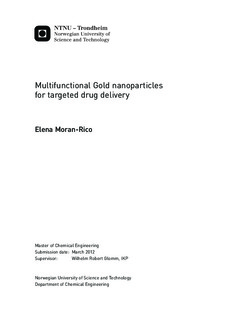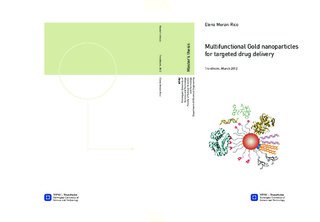| dc.description.abstract | The combination of nanoparticles with pharmaceutically compounds such as small drug molecules, peptides, enzymes, and antibodies, allows the promising development of delivery vectors with superior performance and selectivity. Metal nanoparticles, specifically gold nanoparticles (AuNP), have emerged recently as a suitable material in diverse applications due to their exceptional properties associated with the nanometric scale.
The main aim of this thesis was the synthesis of a new selective drug delivery vector based on the properties of gold nanoparticles. Specifically, the objective of this nanocarrier was the siRNA delivery with the objective to trigger the gene-silencing of the gene therapy. The design of this nanoparticles was established as a gold nanoparticle core covered with chitosan, a biocompatible cationic polysaccharide able to be bound to the gold nanoparticle (AuNP) by charge reversal. Gold nanoparticles were synthesized in different ways and characterized before and after the covering with different samples with the aim of finding the type with the best relation between quickness and strength. Once the AuNP/Chitosan nanoparticles were accomplished, the siRNA covering was attempted to complete the vector. The failure in the adsorption of this siRNA into the chitosan surface was the promoter to try other options to solve this problem.
Second option was the use of hexadecyltrimethylammonium bromide (C16TAB), a cationic surfactant, instead of the chitosan. The vector in this case was established as AuNP/ C16TAB/siRNA and was analysed following the same procedure. C16TAB was adsorbed successfully into the gold surface but the siRNA binding failed.
The last attempt in this research was the come back to the original idea of covering with chitosan to take advantage of its properties. In this case, N-(3-Dimethylaminopropyl) -N-ethylcarbodiimide hydrochloride (EDAC) was used to crosslink the chitosan to the gold surface. This study was carried out with different chitosans samples to characterize the quickness and the strength. The successfully attachment allowed the study of several gold nanoparticles sizes and EDAC concentrations. | |

